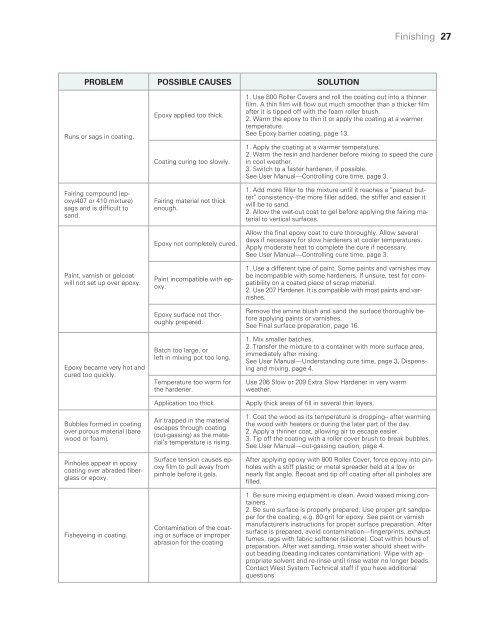Final Fairing & Finishing - WEST SYSTEM Epoxy
Final Fairing & Finishing - WEST SYSTEM Epoxy
Final Fairing & Finishing - WEST SYSTEM Epoxy
You also want an ePaper? Increase the reach of your titles
YUMPU automatically turns print PDFs into web optimized ePapers that Google loves.
PROBLEM POSSIBLE CAUSES SOLUTION<br />
Runs or sags in coating.<br />
<strong>Fairing</strong> compound (epoxy/407<br />
or 410 mixture)<br />
sags and is difficult to<br />
sand.<br />
Paint, varnish or gelcoat<br />
will not set up over epoxy.<br />
<strong>Epoxy</strong> became very hot and<br />
cured too quickly.<br />
Bubbles formed in coating<br />
over porous material (bare<br />
wood or foam).<br />
Pinholes appear in epoxy<br />
coating over abraded fiberglass<br />
or epoxy.<br />
Fisheyeing in coating.<br />
<strong>Epoxy</strong> applied too thick.<br />
Coating curing too slowly.<br />
<strong>Fairing</strong> material not thick<br />
enough.<br />
<strong>Epoxy</strong> not completely cured.<br />
Paint incompatible with epoxy.<br />
<strong>Epoxy</strong> surface not thoroughly<br />
prepared.<br />
Batch too large, or<br />
left in mixing pot too long.<br />
Temperature too warm for<br />
the hardener.<br />
<strong>Finishing</strong> 27<br />
1. Use 800 Roller Covers and roll the coating out into a thinner<br />
film. A thin film will flow out much smoother than a thicker film<br />
after it is tipped off with the foam roller brush.<br />
2. Warm the epoxy to thin it or apply the coating at a warmer<br />
temperature.<br />
See <strong>Epoxy</strong> barrier coating, page 13.<br />
1. Apply the coating at a warmer temperature.<br />
2. Warm the resin and hardener before mixing to speed the cure<br />
in cool weather.<br />
3. Switch to a faster hardener, if possible.<br />
See User Manual—Controlling cure time, page 3.<br />
1. Add more filler to the mixture until it reaches a “peanut butter”<br />
consistency–the more filler added, the stiffer and easier it<br />
will be to sand.<br />
2. Allow the wet-out coat to gel before applying the fairing material<br />
to vertical surfaces.<br />
Allow the final epoxy coat to cure thoroughly. Allow several<br />
days if necessary for slow hardeners at cooler temperatures.<br />
Apply moderate heat to complete the cure if necessary.<br />
See User Manual—Controlling cure time, page 3.<br />
1. Use a different type of paint. Some paints and varnishes may<br />
be incompatible with some hardeners. If unsure, test for compatibility<br />
on a coated piece of scrap material.<br />
2.Use207Hardener.Itiscompatiblewithmostpaintsandvarnishes.<br />
Remove the amine blush and sand the surface thoroughly before<br />
applying paints or varnishes.<br />
See <strong>Final</strong> surface preparation, page 16.<br />
1. Mix smaller batches.<br />
2. Transfer the mixture to a container with more surface area,<br />
immediately after mixing.<br />
See User Manual—Understanding cure time, page 3, Dispensing<br />
and mixing, page 4.<br />
Use 206 Slow or 209 Extra Slow Hardener in very warm<br />
weather.<br />
Application too thick. Apply thick areas of fill in several thin layers.<br />
Air trapped in the material<br />
escapes through coating<br />
(out-gassing) as the material’s<br />
temperature is rising.<br />
Surface tension causes epoxy<br />
film to pull away from<br />
pinhole before it gels.<br />
Contamination of the coating<br />
or surface or improper<br />
abrasion for the coating<br />
1. Coat the wood as its temperature is dropping– after warming<br />
the wood with heaters or during the later part of the day.<br />
2. Apply a thinner coat, allowing air to escape easier.<br />
3. Tip off the coating with a roller cover brush to break bubbles.<br />
See User Manual—out-gassing caution, page 4.<br />
After applying epoxy with 800 Roller Cover, force epoxy into pinholes<br />
with a stiff plastic or metal spreader held at a low or<br />
nearly flat angle. Recoat and tip off coating after all pinholes are<br />
filled.<br />
1. Be sure mixing equipment is clean. Avoid waxed mixing containers.<br />
2. Be sure surface is properly prepared. Use proper grit sandpaper<br />
for the coating, e.g. 80-grit for epoxy. See paint or varnish<br />
manufacturer's instructions for proper surface preparation. After<br />
surface is prepared, avoid contamination—fingerprints, exhaust<br />
fumes, rags with fabric softener (silicone). Coat within hours of<br />
preparation. After wet sanding, rinse water should sheet without<br />
beading (beading indicates contamination). Wipe with appropriate<br />
solvent and re-rinse until rinse water no longer beads.<br />
Contact West System Technical staff if you have additional<br />
questions.
















